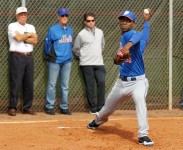Rafael Montero
After last season, you would want to believe that the Mets wouldn’t want to underestimate their own pitching prospects and expose them to the Rule 5 draft.
The Mets got very, very lucky with Logan Verrett. Everyone underestimated him. Perhaps it was a result of a low 90’s fastball. Perhaps it was because he relies on control, changing your eye level, and working both sides of the plate rather than blowing a 100 MPH fastball by you like Noah Syndergaard.
In any event, the Orioles decided he was worthy of a Rule 5 pick but not worthy of making their Opening Day roster. The Rangers scooped him up and decided after six games he couldn’t help them. He was returned to the Mets. He pitched well out of the bullpen and in spot starts. This year he’s made two spot starts and hasn’t allowed a run in 12 innings. The Mets needed him more than they ever knew. Fortunately for the Mets, the Orioles and Rangers never realized what they had in Verrett. The Mets got very lucky.
This year the Mets may not be so lucky with Matt Bowman.
Bowman was taken by the Cardinals in the Rule 5 draft. Partially due to Jordan Walden opening the year on the DL, Bowman made the Opening Day roster. So far this year, Bowman has appeared on five games pitching 6.2 innings. He has a 1.35 ERA and a 0.900 WHIP. He’s predominantly throwing a 93 MPH sinker. He mixes in the occasional slider (88 MPH) and splitter (82 MPH). It’s a short sample size, but Bowman looks good out of the bullpen. There’s no reason to believe the Cardinals will let him go.
The head scratching part was there was no excuse for why the Mets let Bowman become a Cardinal. The Mets had roster space. They could’ve protected Bowman. To make matters worse, they lost what appears to be a good bullpen piece. How did this happen?
In answering, this question it is important to note teams typically keep a roster spot open so they can make a pick in the Rule 5 draft in the event there’s a player out there who can help them. It’s how the Mets acquired Sean Gilmartin last year, and he became a valuable part of the bullpen. So in reality, the question was who should the Mets have left off the roster in place of Bowman.
The Mets did subsequently lose Kirk Nieuwenhuis on waivers. The Mets traded Darrell Ceciliani for cash. Carlos Torres and Ruben Tejada were initially offered contracts only to subsequently be released. The Mets also could’ve realized what they had and did the unconventional and just put Bowman on the roster barring them from making a Rule 5 draft pick. The Mets didn’t. Instead, they exposed Bowman in the draft in the oft chance they could’ve found someone of his caliber in the Rule 5 draft. How did this happen?
Simply put, like Verrett, Bowman didn’t have lights-out stuff. He is a four pitch pitcher that was projected to be, at best, a back of the rotation starter or bullpen arm. He really regressed his first full year in AAA. In 2014, he was 3-2 with a 3.47 ERA and a 1.294 WHIP in six starts and one relief appearance. In 2015, he made 26 starts and two relief appearances. Bowman would finish the year 7-16 with a 5.53 ERA and a 1.679 WHIP. Entering the 2015 season, he was seen as a back of the rotation starter or a bullpen arm. His 2015 season reasonably cast doubt on those projections. At age 25, it appeared like the former 13th round draft pick’s development had stalled.
It didn’t, and it shouldn’t be surprising as Bowman has looked for ways to improve. He has tried to emulate Tim Lincecum‘s delivery. While in college, he studied Sabermetrics, and he has sought to use it to find ways to improve. Basically, there’s no rock this former 13th round pick will leave unturned to he better. He’s built himself into a major league pitcher.
However, Bowman is pitching for the Cardinals, and the Mets have nothing to show for it. Worse yet, the Mets could’ve used him. With Jacob deGrom‘s lat injury (and problems with his son), Verrett was thrust into the starting rotation. Rafael Montero was recalled to help in the bullpen, but Collins has been loathe to use him.
Perhaps Collins would’ve trusted Bowman and allowed him to pitch. Unfortunately, we will never know. The Mets will not get lucky with a Rule 5 pick returning to the organization. Bowman is a Cardinal likely never to return.
Editor’s Note: this article was first published on metsminors.net

Thank goodness for PIP (picture in picture) technology. Because of that, I was able to watch both the Mets-Phillies game and Game Three between the Rangers and Penguins. By the way, if not for my wife and the Declaration of Independence, I’d propose getting rid of Pennsylvania a together.
In any event, the Mets did all people who were both Mets and Rangers fans a huge favor tonight by blowing out the Phillies and giving Rangers fans something to cheer about.
While the Phillies have terrific young starting pitching, we were reminded of the perils of relying on young pitching. While Vincent Velasquez has pitched incredibly well this season (including a terrific game against the Mets), he struggled against the Mets. The Mets jumped on him right away when Michael Conforto hit a two run homer in the first. It was not a good start for Velasquez who only lasted 4.1 innings allowing five hits, five runs (two earned), no walks, and four strikeouts. With the Phillies bullpen, the game was over once Yoenis Cespedes did this:
Watch @ynscspds do bad things to this baseball >> https://t.co/9FZRBHOap4. 5-0 #Mets! ?https://t.co/9ONhf9egGN
— New York Mets (@Mets) April 20, 2016
This was more than enough for Logan Verrett, who once again had a terrific spot start. Verrett would go six innings allowing six hits, no runs, one walk, and four strikeouts. He seemingly had someone on every inning, but he navigated how way through all the trouble.
Overall, it was the type of night you expected from a World Series contender against a team that’s expected to contend for the first pick in the draft. The Mets offense went off hitting six homeruns. Aside from the aforementioned homeruns, the Mets got homeruns from Lucas Duda, Curtis Granderson, and two from Neil Walker. Walker gave one a ride in the ninth but fell just short of a three homerun game. All told, the Mets would score 11 runs.
Things went so well, there was even a Rafael Montero sighting. Keep in mind, that was only after Terry Collins pitched Jim Henderson of an inning to protect the then 9-0 lead. As always, the seventh inning belongs to Henderson.
Montero wasn’t good. He allowed two hits, one earned, one walk, and two strikeouts. It would’ve been much worse if not for a Gold Glove play by Juan Lagares, who came into the game after the blowout started, robbing Maikel Franco of a homerun:
Juan doing Juan things. #Juanderful @juanlagares2https://t.co/a7kqGxuajP
— New York Mets (@Mets) April 20, 2016
Naturally, Collins gave the ball to Hansel Robles in the ninth to preserve the 11-1 victory rather than letting the long man Montero, who will soon be sent back to Triple-A, finish the game.
Right now, the Mets are beginning to get in a rhythm and are beating up on bad teams. It’s what they did very successfully last year. It’s what they’ll need to do in order to return to the postseason.
Game Notes: The Mets are back over .500 at 7-6. Every Mets starter got a hit, including Verrett, who had his first career hit. Verrett has not allowed a run in 12 innings as a starter. Travis d’Arnaud returned to the lineup after getting hit on the elbow on Saturday. The referees are still calling the Rangers-Penguins one-sided even as Sidney Crosby asks for the Rangers to get a game misconduct for giving him a mean look. Rangers trail the Penguins 2-1 in the series.
* photo from the Mets Twitter account

With the Mets bullpen on fumes from a very short Steven Matz start and Logan Verrett making a spot start in place of an injured Jacob deGrom (our prayers are with him and his family), the Mets recalled Rafael Montero to add a fresh arm to the bullpen mix. The Mets needed an extra arm after the bullpen pitched 7.1 innings on Monday without any contributions from their long man. It was a waste of a move. At this point, it’s clear Montero is in Terry Collins’ doghouse, and Collins won’t use him until he’s burned out all of the other arms on the bullpen.
On Wednesday, Collins controversially pitched Jim Henderson despite him having problems locating his pitches and throwing more pitches he ever had in one game the previous night. Collins then proceeded to use Hansel Robles, who pitched 2.2 innings on Monday. Collins went to four relievers that day to preserve a 2-1 win.
On Friday, the Mets had a four run lead. Collins first turned to Antonio Bastardo to get out of a sixth inning jam. He then have way to Robles for 0.1 of an inning. At that point, the Mets had a four run lead in the eighth inning. Collins turned to Addison Reed to get the last six outs. Reed got five and allowed two runs in the process. Collins decided to let Jeurys Familia pitch for the fourth time in four games. Despite allowing a run, he recorded the save.
At no point in either of these games did Montero so much as warm up.
An argument can be made for not using Montero Wednesday because of how close the game was. The Mets were in the midst of a frustrating losing streak, and Collins wanted his best arms out there to get the win. With that said, there’s no reason why Montero didn’t pitch on Friday. After Bastardo got out of the jam, the Mets had a four run lead. That was the perfect spot for Montero.
Instead, Collins asked both Bastardo and Reed to pitch over an inning. He asked two middle relievers to pitch more than an inning rather than asking the long man in his bullpen to pitch more than an inning. Collins was ready, willing, and able to once again tire out his bullpen rather than putting Montero in a game to preserve a four run lead. At this point, it’s fair to say either Collins doesn’t trust Montero, has him in his doghouse, or both.
It’s strange to think it’s reached this point when Collins has tried to get the most out of Montero.
Last August when things were starting to take off for the Mets, Collins drove to Port St. Lucie to have a conversation with Montero in order to tell him the Mets still needed him. At that time, Montero was dealing with shoulder issues. The Mets insisted there was nothing wrong while Montero felt like it prevented him from pitching. Montero tried to make that comeback, but he would have a setback in a rehab start. His season was over.
In Spring Training, Collins again took time to deliver a special message for Montero. As Tim Rohan of the New York Times reported, Collins told Montero, “Get your act together. We haven’t forgotten about you. We still want you.” Collins gave him the start in the Mets first Spring Training game. Montero allowed the first five guys to reach base. In total, he allowed four runs, four hits, and two walks in one inning of work. Montero would not pitch in another game, and he would be in the first group of Spring Training cuts.
At this point, the Mets need Montero. He’s gotten his act together with some mechanical adjustments in Triple-A. However, it’s too little too late. Collins has either forgotten him or doesn’t want him anymore.

Due to the stress Jacob deGrom‘s injury and Steven Matz‘s short start out on the bullpen, the Mets were forced to call-up Rafael Montero to add a fresh arm to the bullpen. Rather than out deGrom on the DL or demote another pitcher, the Mets sent down Eric Campbell. Even with deGrom looking more and more like he will miss his next start, the Mets still won’t put him on the DL. Essentially, the Mets robbed Peter to pay Paul.
With a weekend Interleague series in Cleveland, the Mets can get away with a short bench. While it does limit their ability to pinch hit and make defensive substitutions, they should be able to navigate the situation because they won’t have to pinch hit for a pitcher. However, come Monday, they’re back to playing National League ball, and they’re going to need a full bench.
Whatever your feelings on Campbell is, he’s not going to be eligible to be recalled. Unless deGrom (or someone else) goes on the DL, Campbell will have to spend 10 days in the minors. Looking over the Mets 40 man roster, there would be three eligible candidates: Dilson Herrera, Matt Reynolds, and Brandon Nimmo. Now with one extra spot left on the 40 man roster due to Zack Wheeler being on the 60 day DL, the Mets could recall another player like a Ty Kelly.
In reality, the decision is between Reynolds and Kelly. Nimmo isn’t quite ready, and even if he was, the last thing the Mets need is another outfielder. Herrera still hasn’t started playing games in the field yet due to a sore shoulder, and even if he has been, the Mets see him as the second baseman of the future. They’re not wasting service and development time for him to be on the bench.
Kelly is 27 years old, and he has yet to play in the majors. He plays second, third, and the corner outfield positions. He’s a very disciplined hitter, who is extremely selective at the plate. For reasons that aren’t completely clear, he’s spent five seasons in Triple-A, and he’s never played a major league game. Overall, the truth really is Triple-A is his ceiling. At best, he’s a AAAA player.
Even if that assessment was wrong, it’s still not time to call-up Kelly. First, the Mets would have to add him to the 40 man roster and would not be able to denote him unless he clears waivers. Additionally, his skill set doesn’t match what this team needs. There’s no room for him in the outfield. Terry Collins is going to play Neil Walker almost everyday. So in essence, while Kelly has some versatility, the positions he plays do not match the Mets’ needs.
Accordingly, Reynolds is the player the Mets need to recall. During Spring Training and this early minor league season, Reynolds has played every infield position but first. His addition to the major league roster would create more flexibility across the infield. It would permit Collins to sit both Asdrubal Cabrera and Lucas Duda in the same game. Additionally, it would permit Collins to double switch with any player with the full knowledge that there’s another player on the bench who is fully capable of playing any position should another double switch be needed or there was an injury.
Offensively, Reynolds is a right hand batter who profiles better at the next level than Kelly. He’s not as patient as Kelly, but then again no one is. Reynolds profiles as a gap to gap line drive hitter. He does have more pop in his bat than Kelly. More importantly, at the very least, Reynolds projects as a bench player.
If Reynolds is going to wear a Mets uniform past smiling and waiving before Game One of the NLCS, he’s going to be a super-utility man in the mold of Flores or Joe McEwing. Reynolds has worked hard at it during the offseason and Spring. He knows this is his future, and he’s fully embraced it.
Better yet, he’s scorching hot right now. He’s hitting .353/.476/.529 with a homerun in five games. In those fives games, he’s played second, third, and short. At this point the only plausible reason for not calling up Reynolds is the Mets want to have a short bench.
Reynolds has earned his shot, and he’s playing well. It’s time for the Mets to call-up Reynolds.

After Johan Santana threw 134 pitches on a surgery repaired shoulder to throw the first no-hitter in Mets history, Terry Collins was in tears. He seemed distraught. In the post-game press conference, Collins called Santana his “Hero,” and he was prescient in saying:
I’m very excited for him, but in five days, if his arm is bothering him, I’m not going to feel good.
As we know, even though Santana would make 10 more starts, his career effectively ended that night. He would need another shoulder surgery in the offseason. Between that surgery and other injuries, Santana has never pitched in another big league game.
When Collins was interviewed by Phil Taylor of Sports Illustrated three years later, Collins expressed his remorse. He would say, “It was without a doubt, the worst night I’ve ever spent in baseball.” Now, no one really knows what effect this game had on the need for Santana to have a second surgery. However, for his part, Collins thinks the no-hitter had a lot to do with it:
I was aware of what the wear and tear of that night could do to him, and basically, the worst-case scenario happened. To throw that amount of pitches with that much pressure and that much adrenaline going, it can beat you down. And it did.
If Collins truly believes that, it makes what he did with Jim Henderson all the more indefensible.
Henderson has come a long way to get here. He’s had two shoulder surgeries himself. He fought against all odds to make the Mets Opening Day roster. Not only did he make the roster, he quickly established himself as a very important part of the Mets bullpen.
So far this year, Henderson has pitched in five of the eight games the Mets have played. On Tuesday, he threw 34 pitches, which was the most he’s ever thrown in one game. Wednesday was a day game. The Mets added Rafael Montero to the roster so the Mets would have a full bullpen for the game. With the score tied 0-0 in the seventh inning, Collins put Henderson in the game.
Before Wednesday’s game, Henderson’s fastball averaged 95 MPH. On Wednesday, he was sitting around 89 MPH. He allowed a single and two hits before Collins pulled him from a game he shouldn’t have entered in the first place. Collins excuse?
TC: "Henderson said before the game that he felt great."
— Steve Gelbs (@SteveGelbs) April 13, 2016
It’s difficult to believe that Collins used this as a justification. He says he is troubled by Santana’s no-hitter, and he thinks it had a profound impact on effectively ending his career. Why would he willingly do the same thing again with another player? Why would he go to Henderson when there were other, fresher options? It doesn’t make sense.
It should be noted that Collins had a different tone in Wednesday’s press conference than Santana’s. Collins was fired up. There was no hint of him fearing for Henderson’s future.
Collins thought this was a must-win game, but it’s a stretch to believe he would sacrifice a player’s health for it. Collins said he was desperate, but there has to be a line. Collins might’ve wanted to respond to people questioning the Mets effort, but putting a player’s health and career in doubt, you prove nothing.
At the end of the day, Terry Collins has shown he has learned nothing. While we all understood him leaving Santana in, there was no excuse for pitching Henderson there. Collins could’ve ended someone’s career for what really was just another April game. Overall, Mike Vaccarro put it best when he chastised Collins:
Shame on Terry Collins. That wasn't just reckless game managing, but it put his pitcher's health in peril. #Mets
— Mike Vaccaro (@MikeVacc) April 13, 2016
Collins has had some nice moments as the manager of the Mets. Wednesday wasn’t one of them. Collins once called Santana’s no-hitter the worst night of his baseball life. Wednesday could’ve been the worst day of Henderson’s professional life, but Collins showed no remorse. Collins may be haunted by Santana’s no-hitter, but he has clearly showed he’s learned nothing from it.
Editor’s Note: this was first published on metsmerizedonline.com

After the Mets bullpen had to pitch 7.1 innings on Monday with Steven Matz‘s terrible start, and Logan Verrett having to come out of the bullpen to start in place of Jacob deGrom, the Mets were forced to make a move to add a pitcher to the roster.
There were plenty of good options available to them.
The Mets could’ve utilized deGrom’s paternity leave and called up Rafael Montero. However, the Mets didn’t want to do that because they then couldn’t backdate a potential deGrom DL stint to last Saturday. The Mets could’ve just placed deGrom on the DL, but for some reason they do not appear ready to do that. Apparently, that April 19th game against the Phillies is a must win, and you need deGrom to pitch in that game if at all possible.
No, the Mets decided to demote a player. Looking over the roster, the only pitcher who realistically could be demoted is Hansel Robles. He seems like a natural choice as he pitched 2.2 innings on Monday, and he could use an extra day or two. If Montero falters, the Mets could recall Erik Goeddel or Sean Gilmartin to take his place on the roster.
In this scenario, Robles would have to stay in the minors for 10 days unless the Mets put deGrom (or someone else) on the DL. Given Robles’ current role, losing him for 10 days would be palatable. Montero, Goeddel, or Gilmartin could easily be the long man and/or last man in the bullpen.
Instead of the Mets following the reasonable course of action, they determined it was in their best interests to demote Eric Campbell. In essence, the Mets decided to go with the worst possible choice.
Now,there is nothing wrong per se with demoting Campbell. He’s a career .230/.315/.325 hitter. He has good attributes as a player, but nothing that Campbell has done in his career would ever prevent him from being demoted. However, if he’s being demoted, it should be because the Mets are calling up another position player like Matt Reynolds, not because they are adding a pitcher to the roster.
The Mets demoting Campbell for Montero shortens the Mets bench. In a world where you have David Wright on your team, you should never shorten your bench. On any given day, Wright can wake up sore and not be ready to play. If that happens, not only are you down another player, but you also have no infielders on your bench.
By the way, the Mets are playing a day game after a night game. Terry Collins has said there’s no hard-and-fast rule stating Wright must sit a day game after a night game. However, it’s also true that the Mets have so far refrained from playing Wright in a day game after a night game. No one knows how his back will respond to it. No one knows if he will be able to get loose in time to play a full nine innings.
Instead of taking this into account, the Mets thought it would be best to potentially have no infielders on the bench. The Mets thought it would be best to realistically only have two options on the bench for Wednesday’s game (Collins is loathe to pinch hit with his catcher). Also, apparently, the Mets do not foresee the need to have more than two pinch hitters available in a game where the starting pitcher hasn’t pitched in almost a month and wasn’t stretched out in Spring Training. No, the Mets are setting forth a gameplan where they will have Verrett go deep in the game, and they will be alright with just two bench players. What could go wrong?
The Mets are in the midst of a four game losing streak and would rather potentially sacrifice the the last game of the homestand to give themselves the best possible shot of winning a game against a terrible Phillies team in Philadelphia. The Mets apparently didn’t learn their lesson on Monday about the perils of having a shortened roster.
Overall, the Mets put themselves in a tough position all because they’ve deemed an April game in Philadelphia a must win. Why else wouldn’t you put an injured pitcher who is already missing a start and bullpen sessions on the DL?

Going into the 2016 season, there is one fear each and every Mets fan has. We dare not speak its name, but that doesn’t change the fact that it’s still present. That fear is that a pitcher will get seriously injured.
Looking at this year’s list of pitchers who could befall the dreaded “Verducci Effect,” Noah Syndergaard headlines that list. If Syndergaard was to suffer a season ending injury requiring Tommy John surgery? it would greatly hinder the Mets chances of winning not only the World Series, but also making it to the postseason. It’s something that not just Mets fans fear, but as Anthony DiComo of MLB.com reports, Syndergaard fears it also:
I’ve thought about it quite a bit. But I trust myself to put my body in the right situations to be able to perform at a healthy level.
The fear is justified. Syndergaard threw 65.2 innings more last year. He throws over 95 MPH more than anyone in the game. He’s working to add the fabled Warthen Slider to his already dominant repertoire. Name a risk factor for UCL years requiring Tommy John surgery. Syndergaard meets most if not all of them.
One risk factor not readily discussed is the team he plays for. Look at the projected Mets rotation when healthy: Matt Harvey, Jacob deGrom, Noah Syndergaard, Steven Matz, and Zack Wheeler. Put aside Syndergaard for a moment. What do the other four have in common? They are all hard throwing pitchers under the age of 30 who have already had Tommy John surgery.
Go outside this group. Since Warthen took over as the Mets pitching coach, the following homegrown Mets have sustained arm injuries: Jon Niese (shoulder), Dillon Gee (shoulder), Jeremy Hefner (two Tommy John surgeries), Rafael Montero (shoulder), Bobby Parnell (Tommy John), Josh Edgin (Tommy John), Jack Leathersich (Tommy John). There are more, but you get the point.
Now, is this an organizational problem since Warthen took over, or is it just bad luck? Could this all have been avoided? Back in the 60’s and 70’s the Mets developed pitchers like Tom Seaver, Jerry Koosman, Nolan Ryan, and Jon Matlack. These pitchers threw more innings than the pitchers today, and yet, Matlack was the only one of this group that suffered an arm injury.
In the 80’s, the Mets had Dwight Gooden, Ron Darling, Sid Fernandez, Rick Aguilera, Randy Myers and David Cone. Of this group, only Doc and Cone had arm issues. It should be noted that Doc had many other issues as well, and Cone’s problem was an aneurysm later in his career.
In the 90’s, Generation K was a bust, and the Mets haven’t developed the caliber of starting pitchers like they have in the past until now. However, this generation seems to befall injuries far more often than their predecessors. Is it organizational? Is it bad luck? Is it preparation? For his part, Harvey wonders what if:
I think now, there are things I could have done better in high school or in college to maybe prevent it. But I don’t know. I’m not saying [Syndergaard] works that much harder than everybody else, because we all work hard. I think as time progresses, guys pay more attention to stretching the shoulder, strengthening the shoulder. If I could go back — I don’t know if this would’ve prevented me from having [surgery], but if I could go back and really do 20 extra minutes of stretching and arm care, you never know what could happen.
That’s the thing. We really don’t know why one guy suffers elbow and shoulder injuries while others don’t. Is it preparation? Is it good genes? Is it just good luck? Much time, energy, and money has been spent on this issue, and yet pitchers still get injured. Pitchers get injured despite teams doing everything in their power to try to prevent it.
It will help Syndergaard being in a clubhouse with players who have had Tommy John surgery. They each will have advice for him on why they suffered the injury and what they could’ve done differently. More importantly, Syndergaard appears to be a hard worker who takes the health of his arm very seriously. There is no doubt he is doing everything he can do to avoid the dreaded Tommy John surgery.
Based on what we’ve seen, if anyone can avoid it, it’s him.
Editor’s Note: this article was first published on metsmerizedonline.com

There was a point in time that Rafael Montero was a well regarded prospect. He was once going to force Jacob deGrom into a bullpen role. Now, the only thing we know is the Mets can’t rely upon him right now.
In many ways, 2016 is going to be a make or break year for Montero. Somewhat unfairly the organization turned sour on him last year. He went on the DL in April with shoulder tightness. He was found to have rotator cuff inflammation, which effectively ended his year. In August, he tried to rehab the injury and make some minor league starts, but he again had to be shut down.
This year, Terry Collins wants to challenge Montero as the Mets believe there was really nothing wrong with Montero. Symbolically, the Mets let Montero make the first start in Spring Training on the road against the Nationals.
It didn’t go well. Montero threw 39 pitches in only one inning. He walked four, gave up two hits, and allowed two runs. Not the best of starts. It’s not how he wanted the Spring with the Mets challenging him to be better this year.
At the end of the day, one start shouldn’t mean much. He can go out the rest of Spring Training and pitch very well. He could begin the year in AAA and pitch very well. He could become an injury replacement or spot starter in the rotatio. He could join the bullpen during the year.
There will be opportunities for someone. However, that someone is increasingly becoming someone other than Montero. Last year, Montero was surpassed by Sean Gilmartin and Logan Verrett. They’re likely going to get the first call for spot starts or bullpen work assuming they don’t make come north with the club.
Putting that aside, what was more troubling for Montero was the work of Gabriel Ynoa. He came into the game right after Montero flopped. He threw three scoreless innings and impressed Terry Collins:
Terry Collins says he was very impressed with Gabriel Ynoa today. pic.twitter.com/mSTNgVOFTo
— New York Mets (@Mets) March 3, 2016
Ynoa is a well regarded prospect. He’s ticketed for AAA this year. If yesterday is any indication, it appears that Ynoa is inching past Montero if he hasn’t done so already. While we shouldn’t put too much stock into one Spring Training game, the results today were important. The Mets wanted to challenge Montero to rise to the occasion. Instead, the Mets walked away being impressed with Ynoa.
The problem wasn’t that Montero had a rough outing. The problem is that yet again another Mets pitcher took advantage of an opportunity given to them that was preceded by a Montero failure.

There’s always that player. Despite all evidence to the contrary, you’re convinced they’re going to be good. You can explain away anything that happens.
That’s how I always felt about Aaron Heilman. I thought the Mets never gave him a fair chance to start. They messed around with his arm angles and bounced him between starting and relieving. Sure, I ignored his career 5.93 ERA as a starter (small sample size) and focused upon his good work out of the bullpen in 2006 (regular season). While I believed in Heilman, it just never happened for him. I thought about this when I saw this:
Also, it's pretty clear Jon Niese can be had given where the Mets stand with their rotation. They like Montero as potential fifth starter.
— Mike Puma (@NYPost_Mets) December 7, 2015
Seriously? When will the Mets irrational over confidence in Rafael Montero end? They may trade Jon Niese because Montero has the potential to be the fifth starter. This is the same team that thought Montero should start in 2014 while eventual Rookie of the Year Jacob deGrom should be in the bullpen.
Montero wasn’t good in his initial call-up. He was 0-2 with a 5.40 ERA and a 1.600 WHIP in four starts. He was sent down and injured his oblique. He did come back up and pitched fairly well as a starter. Last year, Montero started in the bullpen. The Mets then sought to move him into the rotation to create a six man rotation to keep everyone fresh. Montero only lasted one start.
He went on the DL with right rotator cuff inflammation. He was transferred from the 15 day to the 60 day DL to make room for Michael Conforto. His rehab was rumored to be progressing slowly. He then had a set-back. His year was effectively over.
It’s not fair to call Montero a bust. It’s still too early in his career for that. It’s also too early to consider him injury prone even if he’s lost big chunks of time over the past two years. With that said, there is no way the Mets should have Montero as a definitive part of their 2015 plans.
It’s widely assumed the fifth starter spot is eventually going to Zack Wheeler. It’s also assumed Niese will hold the spot for at least the first half of the season. After that, he could become trade bait, continue his excellent work in the bullpen, or both. Niese could also be insurance against a starting pitcher getting injured or create a six man rotation to get the other starters some rest.
Montero could do the same, but why would you rely upon him doing that? He hasn’t proven that he can be relied upon. You can trade Niese for a good return. However, you don’t do that because you think Montero could fulfill his spot. He’s been too unreliable to justify that thought process. This front office has a blind spot for him that could’ve meant deGrom in the bullpen. The Mets should learn from this.
Instead, why don’t the Mets go and see how Aaron Heilman’s arm is?

The Mets lost the World Series in large part due to the bullpen blowing three leads in the eighth inning or later. Normally, this would be a point of emphasis in the offseason, but I think there were more pressing issues there:
- There were errors that lead to those blown leads; and
- How the bullpen was deployed.
If these issues are not addressed, I’m not sure it matters if anyone is added to the bullpen. If they are resolved, the Mets have the makings of a terrific bullpen in 2016.
First and foremost, the Mets have a terrific closer in Jeurys Familia. He’s the rare closer that can come in and get a team out of a jam. He’s the rare closer that can go for more than three outs. He’s coming off a year in which he recorded 43 saves, 1.000 WHIP, and a 9.9 K/9. Just when we thought he couldn’t get any better, he developed the devastating splitter.
The issue becomes who will be the other six people in the bullpen. For the other six people you want a 7th inning guy, an 8th inning guy, a long man, and at least one lefty. That leaves you with two guys to either be an extra lefty, an extra long man, or preferably, just a good reliever.
8th Inning
Now, at the end of the year, everyone was clamoring for Addison Reed to replace Tyler Clippard in the 8th inning. It appears everyone will get their wish as the Mets look like they’ll keep Reed and let Clippard walk. As a Met, Reed had a 1.17 ERA with a 1.043 WHIP, and a 10.0 K/9. That’s elite, but it may also be unsustainable.
Reed has a career 4.01 ERA, 1.261 WHIP, and a 9.3 K/9. There could be many reasons for the improvement with the Mets. For starters, Reed improves as the year progresses. In April and May, his career ERA is over 4.00, but from August on it’s under 1.35. Ultimately, it’s great to have a reliever who gets better as the year goes on.
Furthermore, it’s nice having someone with closing experience so the Mets don’t have to overextend Familia during the regular season.
7th Inning
For me, this is obvious. The Mets need to go with Hansel Robles here. He’s a guy who has the ability to get lefties and righties out, and he can go for more than three outs.
In 2015, he had a 3.67 ERA with a 1.019 WHIP and a 10.2 K/9. Those numbers don’t tell the whole story. Once a rookie has pitched for a while, there is tape on him. Typically, this results in some struggles for the rookie until he adjusts. However, Robles got better as the year progressed. Here are his first and second half splits:
- First Half: 4.37 ERA with a 1.191 WHIP and a 7.9 K/9
- Second Half: 3.16 ERA with a 0.891 WHIP and a 12.1 K/9
Like Reed, he got stronger as the year progressed. His was criminally under utilized in a World Series that saw the Mets blow three late inning leads only to lose in extra innings. The Mets shouldn’t make the same mistake in 2016. It’s time to use Robles.
Long Man
Next to Familia closing, Sean Gilmartin being the long man is the biggest lock in the bullpen. He had a 2.67 ERA with a 1.186 WHIP and a 8.5 K/9. He took a strangle hold on this job, and there’s no reason to take it away from him.
LOOGYs
Going into the playoffs, this was the Mets biggest question mark. Fortunately, Jon Niese took over the role quite successfully. However, he will not be an option to re-join the bullpen until Zack Wheeler comes back from Tommy John surgery, which will not be until around the All Star break.
Speaking of injuries, that was the reason the Mets didn’t have a LOOGY. At different times, they had Jerry Blevins, Josh Edgin, Dario Alvarez, and Jack Leathersich go down with injuries. Blevins is free agent, but he’s a candidate to return. Alvarez should be healthy for Opening Day. The Mets also have intriguing prospect Josh Smoker.
There are plenty of viable options here. The Mets should be able to carry one or two LOOGYs from this group.
Remaining Options
After taking the above into account, there will be one or two remaining spots remaining. There are a number of viable candidates:
Erik Goeddel. He is injury prone, but he has good numbers. He had a 2.43 ERA with a 1.000 WHIP and a 9.2 K/9. Those are good mumbers. Numbers that were good enough to land him on the NLDS roster. He should be part of the 2016 bullpen.
Carlos Torres. There are many things you can say about Torres, but the most important one is he’s always available to take the ball. He has a career 4.26 ERA with a 1.357 WHIP and a 7.9 K/9. However, there is value in having someone that can take the ball.
Logan Verrett. He was all over the place last year. He was a starter and a reliever. He kept bouncing back and forth. It didn’t hurt his performance. He had a 3.03 ERA with a 0.879 WHIP and an 8.4 K/9. He should be in the mix.
Jenrry Mejia. He’s one more positive test away from his career being over. He won’t be available until around the All Star Break. He’s likely to be released, which is odd since the Mets haven’t had problems with steroids guys under the Sandy Alderson regime. If he isn’t released, he could help this team in the bullpen. Personally, I’d rather him gone.
Rafael Montero. There was a time the organization believed he was better than Jacob deGrom. When that proved to be false, he was placed in the bullpen to start 2015. The Mets did stretch him out to make go to a six man rotation. He got hurt, and he disappeared. Given the Mets rotation, if he’s going to help the Mets, it’s going to have to be in the bullpen.
Looking over all these options, there is no reason to go outside the organization for bullpen help. Except for Reed, these relievers are cheap, young, and talented. We don’t know the Mets financial situation, but we do know that even if there is no money to spend, the bullpen will be in great shape.
The best part is even if it isn’t, there’s many quality choices in reserve, and that’s just from the players we know.